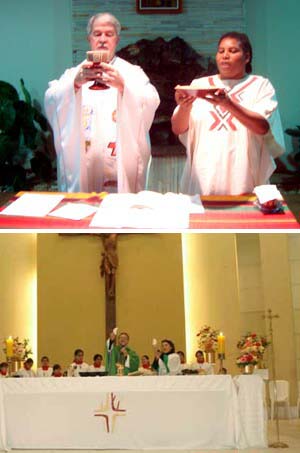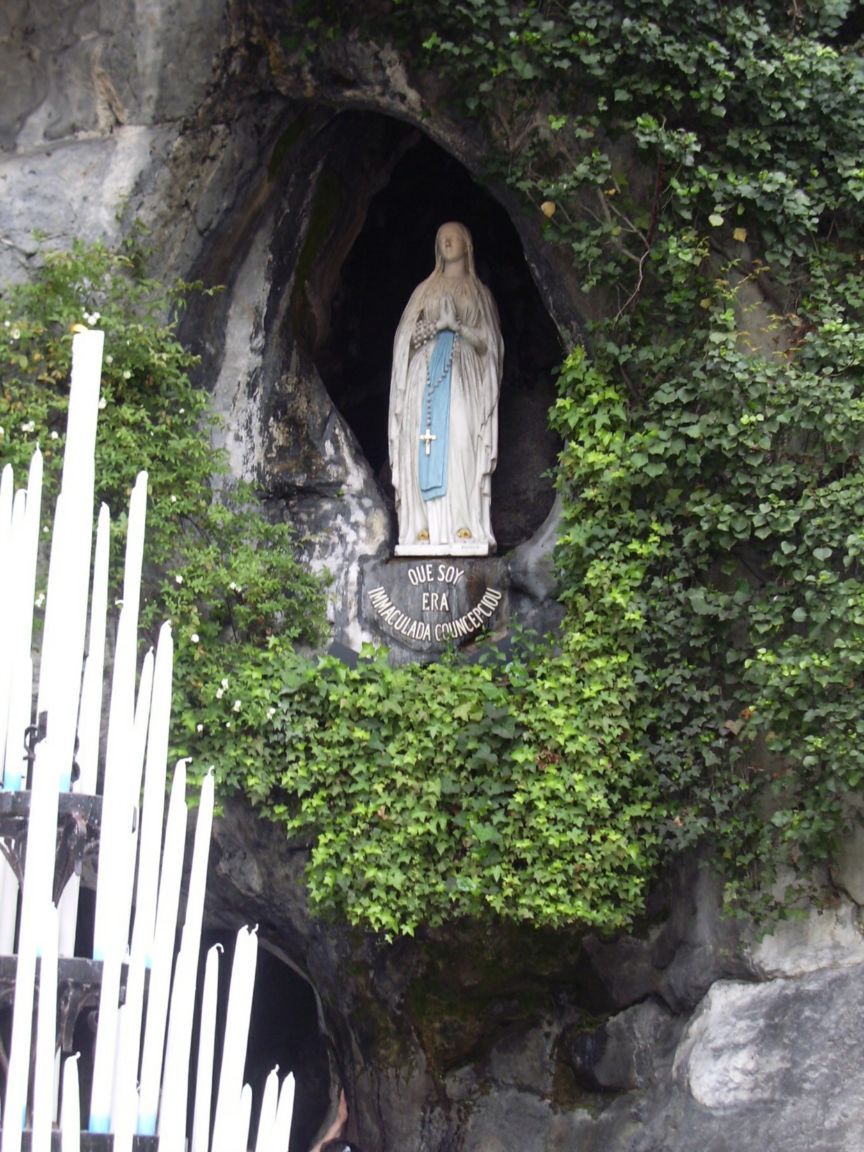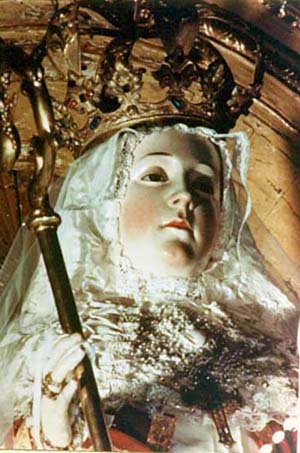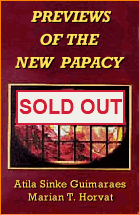Consequences of Vatican II
 |
 |
 |
 |
 |
 |
 |
The Church of Man – Part II
Attack against the Integrity & Unity of the Faith
In the last article we saw that Vatican II established a fundamental inversion in the goals of the Church. Henceforth her goal would be the humanistic aim of serving man on this earth, rather than the supernatural goal of helping him achieve eternal salvation. This article sets out the attack made against the integrity and unity of the Faith.
The Church must change with the times
From the time of her establishment over 2000 years ago, a defining characteristic of the Catholic Church had been the integrity and unity of its Faith. This integrity and unity was due in large part to the Faith being structured in a rigorous way. Such a method perfected itself and generated the scholastic philosophy of St. Thomas Aquinas, which in turn contributed to strengthen the unity of the Faith.
 However, beginning in the 19th century, the philosophies of Liberalism, Modernism and, in the 20th century, Progressivism, achieved increasing influence among intellectuals. What these philosophies have in common is the idea of adapting Catholicism to the modern world, which in turn accepts the principle of a universal evolution.
However, beginning in the 19th century, the philosophies of Liberalism, Modernism and, in the 20th century, Progressivism, achieved increasing influence among intellectuals. What these philosophies have in common is the idea of adapting Catholicism to the modern world, which in turn accepts the principle of a universal evolution.
Soon Modernists, and then Progressivists, defended that no Church truths are permanent and hence must change with the times. Modernist theologians proceeded to challenge both the traditional Catholic Faith and liturgical rites.
The consequences of these novel concepts were so at odds with the traditional Catholic Faith that, less than 15 years after the close of the Council, it was obvious to all, even to non-Catholics, that both the unity and the integrity of the Faith were severely fractured. It was as if the traditional Catholic Faith had been trashed and abandoned.
Moreover, less than 20 years after the close of the Council, the disastrous effects of the changes on the eternal welfare of the souls of the faithful became so apparent that John Paul II declared:
 "We must admit realistically and with feelings of deep pain, that Christians today in large measure feel lost, confused, perplexed and even disappointed; ideas opposed to the truth which has been revealed and always taught are being scattered abroad in abundance; heresies, in the full and proper sense of the word, have been spread in the area of dogma and morals, creating doubts, confusions, and rebellions; the liturgy has been tampered with; immersed in an intellectual and moral relativism and therefore in permissiveness.
"We must admit realistically and with feelings of deep pain, that Christians today in large measure feel lost, confused, perplexed and even disappointed; ideas opposed to the truth which has been revealed and always taught are being scattered abroad in abundance; heresies, in the full and proper sense of the word, have been spread in the area of dogma and morals, creating doubts, confusions, and rebellions; the liturgy has been tampered with; immersed in an intellectual and moral relativism and therefore in permissiveness.
"Christians are tempted by atheism, agnosticism, vaguely moral enlightenment and by a sociological Christianity devoid of defined dogmas or an objective morality." (Feb. 7, 1981, in a conference on "Missions Among Catholic Populations")
In 2003, almost a quarter century later the same JPII admitted:
"The time in which we live seems to be an aberrant epoch where many men and women seem disoriented." (John Paul II, Ecclesia in Europa, nº 7, DC nº 2296, 20 July 2003, pp. 670-671)
And, in that same speech:
"It reigns over Europe a 'sort of practical agnosticism and religious indifferentism' to such a degree that European culture gives the impression of a 'silent apostasy.'" (Ibid, pp. 671-72.)
From the very beginning of her establishment by Jesus Christ over two millennia ago, the Catholic Church has faced serious attacks. Christ warned of these attacks when he said: "Do not think I came to send peace on earth: I came not to send peace, but the sword." (Matt. 10:34)
Warnings by the Virgin Mary
 Throughout the history of the Church, the Blessed Virgin, in the role of God's emissary, has appeared on earth to give messages to various individuals. In recognition that the Church would need help in dealing with the more serious of the attacks, her messages addressed these attacks and crises.
Throughout the history of the Church, the Blessed Virgin, in the role of God's emissary, has appeared on earth to give messages to various individuals. In recognition that the Church would need help in dealing with the more serious of the attacks, her messages addressed these attacks and crises.
For example, one such serious attack was the accusation that Mary, the Mother of Jesus, was not immaculately conceived. To assist the Pope in defending the Church's teaching of the Immaculate Conception, in 1858 God had the Blessed Virgin appear to a simple, innocent and uneducated young girl, Bernadette Soubirous in Lourdes, France.
The Blessed Virgin revealed to Bernadette that: "I am the Immaculate Conception," To give credence to both her message and her appearance, she told Bernadette to start digging in the ground, which she did, earning the scorn of the observing towns people. Immediately, however, water began flowing from the spot, and eventually a tiny stream appeared which grew to a small river whose water - when bathed in or drunk - has been responsible for healing thousands of seemingly impossible-to-cure sick people.
The seriousness of the attacks on the traditional Catholic Faith beginning in the 20th century is evident by God having the Blessed Virgin warn of such attacks several centuries prior to them.
In Quito, Ecuador, on February 2, 1594, nearly 400 years prior to the close of Vatican Council II, she began a set of apparitions to Mother Mariana de Jesus Torres, a Conceptionist nun of the royal Convent of the Immaculate Conception.
At the first visit, the Blessed Virgin told the nun that near the end of the 19th century and for a great portion of the 20th century, various heresies would flourish in the Church, impurity would reign, the sacraments would be attacked and profaned, priests would become attached to wealth and riches and vocations would be lost. (Our Lady of Good Success, Prophecies For Our Times, M. T. Horvat)
 A similar warning was given to Pope Leo XIII on October 18, 1884. At end of celebrating Mass, the Pope suddenly appeared pale and shaken and said he overheard a conversation in which Satan asked God for 75 to 100 years so that he could destroy the Church. ("Viruses in the Body of Christ", The Latin Mass, Fall 1998, pp. 28-40)
A similar warning was given to Pope Leo XIII on October 18, 1884. At end of celebrating Mass, the Pope suddenly appeared pale and shaken and said he overheard a conversation in which Satan asked God for 75 to 100 years so that he could destroy the Church. ("Viruses in the Body of Christ", The Latin Mass, Fall 1998, pp. 28-40)
Yet another warning was given to two children, Melanie Calvet and Maximin Giraud, on September 19, 1886, at La Salette, France, in which the Blessed Virgin revealed that Rome would lose the Faith and become the seat of the Antichrist and the Church would be in eclipse. (Apparition of the Blessed Virgin on the Mountain of La Salette, the 19th of September, 1846, published by Shepherdess of La Salette)
In the 20th century, in 1917, the Blessed Virgin gave several messages to three young children in Fatima, Portugal, warning of a future chastisement if man did not convert and repent.
Also in the 20th century, in the year 1973 in Akita, Japan, the Blessed Virgin delivered three messages to a young deaf nun, Sister Agnes Sasagawa. The content of the messages were in complete accord with those to the three children at Fatima. In each set of apparitions, the messages of both Our Lord and His Blessed Mother, emphasized the need to cease the committing of sins. The messages encouraged the recitation of prayers, particularly the Rosary, together with the necessity of performing acts of reparation for one's sins as well as for the sins of others.
The essential characteristic of all of the messages was their complete agreement with the purpose for which Jesus established the Church and with the means He gave for achieving that purpose.
It is fundamental to note that an apparition by the Blessed Virgin is a direct manifestation of the will of God, and thus her messages are those which God desired her to give. Consequently, the messages provide a valid basis for evaluating the degree to which the Council induced novel changes are in accord with Christ's purpose for His Church by comparing the many Vatican II changes in the Faith and the liturgy to the earthly messages of both Our Lord and His Mother.
Such a comparison will readily show that many of the new teachings and actions of the conciliar Church are in opposition to the words of Jesus and His Mother, and hence are counter to the purpose for which Jesus established His Church. It is the aim of these articles to provide such comparisons and thus validate this assertion.
Changes that do not glorify God or save souls
Almost immediately after the close of the Council, controversy arose over the many changes in both the liturgical rites and the traditional teachings of the Church. With the passing years the intensity of the controversy has increased and now, nearly a half century after its close, there is increasing talk of the need for a complete reassessment of the Council deliberations.
Since it is a de fide and fundamental tenet of the Catholic Faith that the purpose of the Catholic Church is to give honor and glory to God and to save souls, the true measure of acceptance of any change in the liturgical rites or the traditional teachings of the Church must be the degree to which the change better enables the giving of honor and glory to God and the salvation of souls.
Furthermore, since it is God who gave the teachings to the Apostles and it is God, not man, who will judge the degree to which God's teachings are fulfilled, the measure cannot be based on the degree to which such a change fulfills Pope Paul VI's boast of serving man or by how well the change enables the Church to adapt to the mores and ethics of a modern ever-changing world. Nor does it depend on how skillful and nuanced the rationale supporting the change might be.
In short, the criterion is this: "Does it save souls?" This was the question always asked by Fr. Alfred Kunz, a priest in Dane, Wisconsin, who is believed to be murdered because of his strong stand for the traditional moral teachings of the Church, whenever he was asked about a new change or teaching for the Church.

The Church must change with the times
From the time of her establishment over 2000 years ago, a defining characteristic of the Catholic Church had been the integrity and unity of its Faith. This integrity and unity was due in large part to the Faith being structured in a rigorous way. Such a method perfected itself and generated the scholastic philosophy of St. Thomas Aquinas, which in turn contributed to strengthen the unity of the Faith.

The Church was steered safely & soundly under the teaching of St. Thomas
Soon Modernists, and then Progressivists, defended that no Church truths are permanent and hence must change with the times. Modernist theologians proceeded to challenge both the traditional Catholic Faith and liturgical rites.
The consequences of these novel concepts were so at odds with the traditional Catholic Faith that, less than 15 years after the close of the Council, it was obvious to all, even to non-Catholics, that both the unity and the integrity of the Faith were severely fractured. It was as if the traditional Catholic Faith had been trashed and abandoned.
Moreover, less than 20 years after the close of the Council, the disastrous effects of the changes on the eternal welfare of the souls of the faithful became so apparent that John Paul II declared:

In Brazil women are allowed to take part in the Consecration; top, in Goiania, bottom in Curitiba
"Christians are tempted by atheism, agnosticism, vaguely moral enlightenment and by a sociological Christianity devoid of defined dogmas or an objective morality." (Feb. 7, 1981, in a conference on "Missions Among Catholic Populations")
In 2003, almost a quarter century later the same JPII admitted:
"The time in which we live seems to be an aberrant epoch where many men and women seem disoriented." (John Paul II, Ecclesia in Europa, nº 7, DC nº 2296, 20 July 2003, pp. 670-671)
And, in that same speech:
"It reigns over Europe a 'sort of practical agnosticism and religious indifferentism' to such a degree that European culture gives the impression of a 'silent apostasy.'" (Ibid, pp. 671-72.)
From the very beginning of her establishment by Jesus Christ over two millennia ago, the Catholic Church has faced serious attacks. Christ warned of these attacks when he said: "Do not think I came to send peace on earth: I came not to send peace, but the sword." (Matt. 10:34)
Warnings by the Virgin Mary

Our Lady appeared at Lourdes to help mankind turn to her
For example, one such serious attack was the accusation that Mary, the Mother of Jesus, was not immaculately conceived. To assist the Pope in defending the Church's teaching of the Immaculate Conception, in 1858 God had the Blessed Virgin appear to a simple, innocent and uneducated young girl, Bernadette Soubirous in Lourdes, France.
The Blessed Virgin revealed to Bernadette that: "I am the Immaculate Conception," To give credence to both her message and her appearance, she told Bernadette to start digging in the ground, which she did, earning the scorn of the observing towns people. Immediately, however, water began flowing from the spot, and eventually a tiny stream appeared which grew to a small river whose water - when bathed in or drunk - has been responsible for healing thousands of seemingly impossible-to-cure sick people.
The seriousness of the attacks on the traditional Catholic Faith beginning in the 20th century is evident by God having the Blessed Virgin warn of such attacks several centuries prior to them.
In Quito, Ecuador, on February 2, 1594, nearly 400 years prior to the close of Vatican Council II, she began a set of apparitions to Mother Mariana de Jesus Torres, a Conceptionist nun of the royal Convent of the Immaculate Conception.
At the first visit, the Blessed Virgin told the nun that near the end of the 19th century and for a great portion of the 20th century, various heresies would flourish in the Church, impurity would reign, the sacraments would be attacked and profaned, priests would become attached to wealth and riches and vocations would be lost. (Our Lady of Good Success, Prophecies For Our Times, M. T. Horvat)

At Quito Our Lady warned of a great crisis in the Church in the 20th century
Yet another warning was given to two children, Melanie Calvet and Maximin Giraud, on September 19, 1886, at La Salette, France, in which the Blessed Virgin revealed that Rome would lose the Faith and become the seat of the Antichrist and the Church would be in eclipse. (Apparition of the Blessed Virgin on the Mountain of La Salette, the 19th of September, 1846, published by Shepherdess of La Salette)
In the 20th century, in 1917, the Blessed Virgin gave several messages to three young children in Fatima, Portugal, warning of a future chastisement if man did not convert and repent.
Also in the 20th century, in the year 1973 in Akita, Japan, the Blessed Virgin delivered three messages to a young deaf nun, Sister Agnes Sasagawa. The content of the messages were in complete accord with those to the three children at Fatima. In each set of apparitions, the messages of both Our Lord and His Blessed Mother, emphasized the need to cease the committing of sins. The messages encouraged the recitation of prayers, particularly the Rosary, together with the necessity of performing acts of reparation for one's sins as well as for the sins of others.
The essential characteristic of all of the messages was their complete agreement with the purpose for which Jesus established the Church and with the means He gave for achieving that purpose.
It is fundamental to note that an apparition by the Blessed Virgin is a direct manifestation of the will of God, and thus her messages are those which God desired her to give. Consequently, the messages provide a valid basis for evaluating the degree to which the Council induced novel changes are in accord with Christ's purpose for His Church by comparing the many Vatican II changes in the Faith and the liturgy to the earthly messages of both Our Lord and His Mother.
Such a comparison will readily show that many of the new teachings and actions of the conciliar Church are in opposition to the words of Jesus and His Mother, and hence are counter to the purpose for which Jesus established His Church. It is the aim of these articles to provide such comparisons and thus validate this assertion.
Changes that do not glorify God or save souls
Almost immediately after the close of the Council, controversy arose over the many changes in both the liturgical rites and the traditional teachings of the Church. With the passing years the intensity of the controversy has increased and now, nearly a half century after its close, there is increasing talk of the need for a complete reassessment of the Council deliberations.
Since it is a de fide and fundamental tenet of the Catholic Faith that the purpose of the Catholic Church is to give honor and glory to God and to save souls, the true measure of acceptance of any change in the liturgical rites or the traditional teachings of the Church must be the degree to which the change better enables the giving of honor and glory to God and the salvation of souls.
Furthermore, since it is God who gave the teachings to the Apostles and it is God, not man, who will judge the degree to which God's teachings are fulfilled, the measure cannot be based on the degree to which such a change fulfills Pope Paul VI's boast of serving man or by how well the change enables the Church to adapt to the mores and ethics of a modern ever-changing world. Nor does it depend on how skillful and nuanced the rationale supporting the change might be.
In short, the criterion is this: "Does it save souls?" This was the question always asked by Fr. Alfred Kunz, a priest in Dane, Wisconsin, who is believed to be murdered because of his strong stand for the traditional moral teachings of the Church, whenever he was asked about a new change or teaching for the Church.

Posted July 5, 2013
______________________
______________________











